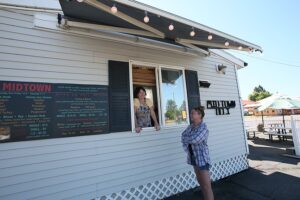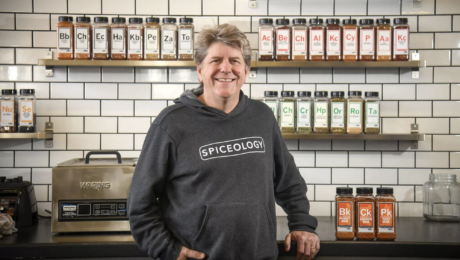This article first appeared in the Spokane Business Journal on July 15th, 2021, (Updated 7/16/2021 with new project cost and timeline on the Interstate 90-state Route 41 project.) by Kevin Blocker.
Established in Portland, Oregon in 1976, the transportation civil engineering consulting company David Evans & Associates Inc. has secured a solid presence in the Inland Northwest.
Especially in Idaho.
Despite the fact the biggest share of the company’s Inland Northwest employees are based in Spokane, it tends to secure more work in Idaho than in Eastern Washington.
“Idaho has a more robust program for consultants,” says Russell Leahy, the company’s transportation market leader for the Inland Northwest.
“(Washington state Department of Transportation) does a lot of work internally, so they don’t give much work to consultants,” Leahy says. The situation is similar for both the cities of Spokane and Spokane Valley, he adds.
“Idaho typically runs lean, and they rely more on consultants to help deliver their work,” Leahy says. “We have a breadth of technical skills across the area and across the company that we can draw from. If we do a project here, we can pull people in from all over the company. We have the horsepower to deliver on tight time frames.”
The company has 750 employees in Washington, Idaho, Oregon, Utah, California, Colorado, Nevada, Texas, Mississippi, South Carolina, and New York.
Roughly 35 employees are based in in the company’s Spokane office with another 20 in the Coeur d’Alene office.
Due to COVID-19, however, a significant part of the company’s Inland Northwest workforce is scattered across the region and working remotely, he says.
“We’ve got people in Clarkston (Washington), Lewiston (Idaho) … one in Riggins, Idaho,” he says.
More recently, a significant portion of David Evans & Associates’ Inland Northwest staff has increasingly turned its attention to a planned two-year, $57.2 million Idaho Transportation Department project for which the company is the consultant and design company.
Though he declines to provide specific revenue figures, Leahy says company revenues and projects have been on the rise in the last two to three years.
The project, for which construction will begin in 2023, involves the complete realignment of the Interstate 90-state Route 41 interchange in Post Falls.
“That is a major interchange upgrade to take a lot of the current goofiness out it,” Leahy says in reference to the area’s often inconsistent traffic flow. “But it’s going to be a disruption to everyone driving on the interstate because there’s going to be a lot of work on it.”
When finished, a portion of state Route 41 just off the freeway will be relocated to the west of its current location.
“By moving it away from the hillside, that’s going to allow us to move the westbound off ramp to prevent cars from backing up on the freeway the way they often do now,” he says. “It will give more time and room for people to slow down coming off the freeway.”
“The ultimate goal is to increase the operational efficiency of the interchange,” Leahy says. “It’s a really exciting project for us.”
David Evans & Associates also is the consulting and design company for ITD’s soon-to-be completed realignment of the state Route 53-U.S. 95 interchange just north of Coeur d’Alene and eight miles north of I-90.
In Spokane
But David Evans & Associates also secures a substantial amount of work in the Spokane area, Leahy says.
The civil engineering company currently is operating as the consultant to WSDOT for the current realignment project involving North Barker Road at East Trent Avenue in Spokane Valley, he says.
The project will place a roundabout at Barker and Trent while moving vehicle traffic below a BNSF Railway Co. line bridge to slow traffic while separating motorists from the rail line, he says.
“The separation of vehicular traffic from the railroad tracks is the big facet of that project,” says Leahy, of WSDOT’s desire to reduce keep motorists and trains away from each other as much as possible.
Leahy, a 15-year employee at the company, says most employees at the company have long-standing tenure.
“That’s one of our strengths; we’re a very stable company,” he says.
Despite that, Leahy says it has been a challenge to add more staff to the company’s Inland Northwest operations.
“Following the financial crisis of 2008, 2009, for two or three years, no one was hiring civil engineers,” he says. “A lot of people went to other fields and careers. Even still, it’s really hard to find good engineers right now.”
The growth in the Boise area, however, did result in the hiring of an additional 20 civil engineers to the company to handle work on burgeoning projects there, Leahy says.
“We’re hiring anybody we can right now, if they have skills and are good,” he says.
Like this story?
You’ll love the rest. Subscribe today, and you’ll receive a year’s subscription to the Journal of Business, unlimited access to this website, daily business news emails, and weekly industry-specific
e-newsletters. Click here for 50% off your first year.
This article first appeared in the Spokesman Review on May 21, 2021. By Amy Edelen [email protected](509) 459-5581
Kootenai County companies saw an uptick in investment despite the pandemic last year, according to a recent report by the Idaho Technology Council.
The council’s 2020 Idaho Deal Flow report, released earlier this week, tracks private funding, public market transactions and mergers and acquisitions.
North Idaho had 10 company mergers and acquisitions and 26 private investment deals last year totaling $164.3 million, according to the report.
Companies in Kootenai County garnered more than $67.7 million in funding from investors last year.
Ryan Arnold, director of regional entrepreneurial strategy at North Idaho College, said Thursday that 2020 was an interesting year for North Idaho’s business community.
At the onset of the pandemic, the region’s startup activity was expected to decrease, but the opposite occurred as more entrepreneurs took risks and developed business ideas, Arnold said.
“We saw an uptick in entrepreneurship activity,” he said.
North Idaho is now on the map as a viable area to obtain funding and conduct business, in part, because of its proximity to Spokane, Seattle and Boise, Arnold said.
“Overall, it feels like a good time to be here,” Arnold said.
Statewide, the number of investment deals dropped slightly to 151 last year, compared with 154 in 2019. However, the overall amount of capital invested increased to $5.2 billion last year from $4.4 billion in 2019.
Coeur d’Alene-based Tractor Beverage Co. last year was among the state’s top 10 private placement deals, a round of investment through a private offering . The specialty soda company completed an $18.5 million round of venture funding from investors in 2020.
“Our equity raise completed in April 2020 has enabled Tractor to continue its growth in the industry and helped us achieve a 475% increase in revenues in 2020,” Dan Kerker, CFO of Tractor Beverage Co., said in an email.
Seven Kootenai County-based companies raised more than $1 million in funding last year. GarageSkins Inc. is one of those companies, raising $1.2 million in December in a deal led by Central Texas Angel Network.
GarageSkins founder Rick Medlen moved from Oregon to Liberty Lake last year and is leasing 60,000 square feet of space at 5405 W. Riverbend Ave. in Post Falls for a new production facility, with plans to take the company’s garage door overlay system to market in July.
Medlen developed a concept of thin, wood veneers adhered to lightweight foam that attaches to metal garage doors via strong earth magnets, transforming the appearance to high-end wood carriage doors without need for alterations.
“I have found North Idaho to be incredibly welcoming to new businesses,” said Medlen, adding the business community has been supportive of the company’s production facility.
It’s been typical to see late-stage funding for North Idaho startups, meaning established companies are receiving larger amounts of investments, Medlen said.
“Companies showing true growth and great year-over-year increases can expect a ready investor market,” he said.
Now available in our Speaker Presentation Library, our recent webinars have been recorded:
INP 2021 Winter Webinar: Retail & Restaurant Recovery
Heather Thomson – It’s a Tall Order
Josh Wade -Hospitality Survival Strategies
Webinar Recording—> Click here!
*************
INP 2020 Winter Webinar:The Importance of Digital Inclusion
Monica Babine: Setting the Stage
Russ Elliott: State Programs & Resources (WA)
Eric Forsch: State Programs & Resources (ID)
Mike Kennedy: A Provider’s Perspective
Debra Hansen: Broadband Action Teams: How to Engage Your Community Utilizing the BAT Model
Broadband Action Team (BAT) Information Sheets
Webinar Recording—>Click here!
************
INP 2020 Fall Webinar: 2020 Regional Economic Outlook
Sam Wolkenhauer: Inland Northwest Labor Market Trends (ID)
Ajsa Suljik: Inland Northwest Labor Market Trends (WA)
John Mitchell: 2020 Regional Economic Outlook-COVID, Zooming & Resilience
Webinar Recording—> Click here!
This article first appeared in the Journal of Business on January 14, 2021. By Patrick Jones, executive director of the Institute for Public Policy & Economic Analysis at Eastern Washington University.
Supply side said to have greater effect as listings fall short of local demand
Ever thought it’s those out-of-towners who have driven up housing prices here recently? You probably aren’t alone.
After all, the median house price for resale has climbed from approximately $284,000 to $330,000 over the past four quarters.
That $46,000 represents a 16% bump, a steep one for buyers. Spokane’s median price, while still considerably lower than the state value, cruised upward at a slightly higher pace than Washington’s median, which rose 14% over the past 12 months. (Supporting data is available on Eastern Washington University’s Spokane Trends website.)
Prices reflect many forces, both demand and supply. The key drivers of housing demand are income, financing, and population. Incomes here have moved upward in the past few years, but at a rate not too far from historical rates. For sure, mortgage rates have plummeted, leading some homeowners to consider trading up and some renters to consider buying.
Population growth, too, has surged over the past four years, relative to the past two decades. And like most western U.S. cities, Spokane’s population has expanded largely due to migration.
Local families continue to keep OB-GYNs busy, but in the larger scheme of things, it is migration that moves the population needle. For example, from April 1, 2019, to April 1, 2020, the number of heads in Spokane County rose by 7,350. Of those, 85% can be attributable to net migration.
Net migration accounts for the difference between those who move in and those who move out. Over the past five years, the number of county residents here due to net migration has been slightly more than 25,000. That’s a large jump from the prior five years.
Has it been just me who has seen more out-of-state license plates on Division Street or Interstate 90 since the pandemic struck? Observations from behind the wheel are not optimal research techniques. Thankfully, we can look at a public data series: driver’s license surrenders tracked by the Washington state Department of Licensing.
The surprise result for the first 11 months of the year: out-of-state license surrenders have dropped. From January through November the Department of Licensing reports about 7,700 new residents from outside of our state exchanging driver’s licenses. That total is down from 9,160 and 10,830 for the first eleven months of 2019 and 2018, respectively. So much for casual empiricism.
In retrospect, that shouldn’t be too surprising. The early months of the pandemic’s outbreak put a hard stop to mobility in this country.
A comparison of license surrenders in the second quarter of this year with the second quarter of 2019 is startling: 104 this year versus 2,360 last year.
Undoubtedly, the low numbers from this year are due to the closure of state offices for a good part of the quarter. Yet the third quarter, when obstacles to reregistering ostensibly were removed, didn’t compensate for the prior quarter. Licensing data show a gain of little more than 200.
In sum, the continued discovery by those from out-of-state, so strong in the recent years, shifted gears in 2020.
Yet, inflows might still be strong from movers within the state. The U.S. Census tracks annual flows from county to county in the U.S, compiled over five-year intervals. The most recent period is 2014-2018. It clearly shows the flow of Washingtonians to our county to be considerable.
Over that interval, the ratio of new residents to Spokane from Washingtonians to those outside of the state was just slightly below even. That is, a few more new residents have recently come from outside the state than from the other 38 counties in Washington.
It might be the case that the pandemic has changed that relationship, making it relatively easier for residents of Evergreen State counties to move here than those from hundreds of miles away.
In fact, among the top 10 U.S. counties contributing to in-migration here over the 2014-2018, period, seven were in Washington. Ranked by size of their flows, these were: Snohomish, King, Benton, Grant, Pierce, Stevens, and Lincoln counties.
Of the two out-of-state counties, one, not surprisingly, is neighboring Kootenai County, and the other, perhaps surprisingly, is Maricopa, Arizona. Though not a county, Asia as a whole rounded out the top 10.
Most of us have heard anecdotes about neighbors or friends of friends who have moved here from the central Puget Sound area. Many of the accounts describe the new residents as remote workers. That arrangement may well be part of the new normal for our economy and in particular for tech workers.
If so, these new neighbors symbolize a hope held by many in the economic development community: Someday Spokane will benefit from an arbitrage of labor from high-cost to lower-cost urban centers.
It is this observer’s hunch that current movement from other Washington counties has mirrored the decline of out-of-state new residents in 2020.
As a consequence, fingers can’t be pointed at Seattleites for the dramatic run-up in housing costs. Until we have data for 2020, we simply won’t know.
Attempts to explain housing prices solely to increased demand, however, miss half of the equation, perhaps the greater half. The supply side must be considered. Here, as has been widely noted, the offering of Spokane homes has been lowest on recent record.
The Washington State Real Estate Research Center, source for some of the housing data on Spokane Trends, tracks the number of listings by quarter in the county. For Q3 2020, the most recent quarter for which data are available, the count stood at 558. Compare that with 1,158 listings in Q3 2019, or 2,562 listings in Q3 2015.
Population has grown, incomes have grown, financing has gotten much more favorable, yet supply has diminished. Clearly this is a textbook case for rising prices.
The supply of homes (listings) rests on two sources: the number of local households selling their homes and the number of new homes coming onto the market. Spokane Trends doesn’t track the latter, but does follow residential building permits, typically viewed as a leading indicator. (See indicator 2.3.3.) The graph clearly shows a peak in 2016, followed by a decline of 500 permits into 2019.
The reasons behind the decline are numerous.
They include: difficulty in securing land, the cost of developing lots, a tight labor pool in the building trades, and the rising costs of construction, especially lumber. Some of these forces might see some relief relatively soon, but others will take longer to resolve.
That is, unless hundreds of current Spokanites decided to sell and move to a different place. That doesn’t seem to be in the offing now. The pandemic has kept local residents place-bound, too. Once our community reaches a safe threshold of vaccinations, I don’t expect a big outflow. Continued low supply, growing popularity from outside the region, continued low financing costs, and no significant rise in departures imply rising home prices for the foreseeable future.
This article first appeared in the Journal of Business on October 22nd, 2020. . Written by Natasha Nellis
Spokane-based wholesale cooperative URM Stores Inc. has purchased the former Northwest Bedding complex on the West Plains to accommodate ongoing growth, as the organization expands west of the Cascade Mountains.
Located at 6102 S. Hayford Road, just west of the Amazon Fulfillment Center and north of West Plains Building Supply, the newly acquired property includes two warehouses with nearly 140,000 square feet of floor space—one with 117,900 square feet of space and the other with 16,000 square feet.
The structures will be used as additional staging and storage space, says Mike Winger, vice president of store development.
“It gives us some flexibility to better utilize the main URM facility,” he says.
A commercial change-of-use application on file with Spokane County shows tenant improvements in both structures are valued at about $12.4 million. URM purchased the 13.8-acre property for $3.7 million in September, according to Spokane County Assessor’s Office records.
The recently acquired Hayford Road structures previously operated as a boat manufacturer, Sun Runner, from 1977 to 1991 before transitioning into a Northwest Bedding manufacturing facility, says James Black III, Realtor with NAI Black who handled the transaction. The property has been vacant for roughly two years.
The expansion comes on the heels of a double-digit growth in revenues during the most recent fiscal year.
In its 2020 fiscal year ended July 31, the company experienced double-digit sales growth and closed out the year at a consolidated annual revenue of $1.3 billion, up 13% compared with 2019 revenue, Winger says.
Much of that growth is attributable to the COVID-19 pandemic, as more people cook at home and drive up sales at grocery stores, which in turn drives up sales at the wholesale cooperative, he says.
“The way the virus has impacted the restaurant trade has really changed people’s eating habits, and a lot of our retailers have experienced significant sales growth because people are now going to the grocery store and buying a lot of that center-store grocery product,” he contends.
Winger says it’s likely the new facilities will operate with a limited staff, as the facility is intended to be used as a temporary dry food storage facility. However, he adds, the significant growth and demand the company has seen this year has led to over 80 new hires at the URM headquarters, and the company is looking to add 30 to 35 additional employees before year’s end.
URM currently has over 670 employees.
In addition to eliminating periodic expenses related to off-site storage during the holiday seasons, the new facilities give URM expanded storage capabilities that Winger says will allow the company to better serve its growing client base in the large Pacific Northwest metropolitan areas.
“With the growth of our company, we’ve been pushing our trade area farther west,” says Winger. “Now, we service grocers over in the Seattle and Portland area.”
He adds that as more retailers are added to the company’s roster, the demand for specialty products could increase. The new facility will help to accommodate those products that the company headquarters, at 7511 N. Freya, currently doesn’t now.
Further, he says the grocery industry is continuously evolving, with new products being added every day, organic products growing in popularity and diversity, and ethnic foods growing in demand.
The new space will give the company the flexibility to accommodate those needs in the future as the company’s retailer base diversifies, he contends.
During the holiday season, the distributor often rents additional space to store the candy and other holiday treats the member companies only stock seasonally, Winger explains, so having the additional space will cut that expense.
The West Plains facilities currently are undergoing tenant improvements to ensure that the buildings are up to date with code requirements, he says. The buildings also aren’t connected to city water or sewer systems, and instead operate on a private well, so the company is inspecting them to ensure the life safety systems are operational, he adds.
Winger says improvements are slated to be completed by spring 2021.
“We have, for some time, been looking to see how we could expand our existing warehouse facility. We’re somewhat limited because we have the railroad property to the west of us and we have streets on either side,” he says of the company’s headquarters on Freya Avenue.
Much of the planned work is cosmetic, adds Winger. Additionally, the structure’s roof will be replaced, portions of the steel panel wall will be repaired, and the loading docks will need to be repaired or replaced to be properly sized for the company’s trucks, he says.
URM’s flagship distribution center on Freya Street is 680,000 square feet. According to the company’s website, its distribution center receives over 400 inbound truckloads weekly and ships over 450 outbound truckloads a week.
Its headquarters were established in Spokane in 1926. Since, the company has steadily expanded its space, with its last addition occurring in 2014 when the company added 77,000 square feet to its perishable groceries space.
URM services members in Washington, Idaho, Montana, and Oregon. Its offerings include dry groceries, frozen food, ice cream, deli foods, dairy products, fresh meat, general merchandise, and health and beauty aids.
The 99-year-old cooperative is a member-owned food distributor to grocers that include Center Place Market, Family Foods, Harvest Foods, Huckleberry’s Natural Market, Rosauers Supermarkets, Super 1 Foods, The Markets LLC, Town & Country Markets Inc., Yoke’s Fresh Market, and Northwest Grocers.
The company also provides supplies to two URM Cash & Carry stores.
Next year URM Stores will celebrate its 100th year, says Winger.
this article first appeared November 5 in the Spokane Journal of Business. Written by Kevin Blocker.
Extended holiday shopping season benefits some here
Despite the fact thousands of retail storefronts across the U.S. have struggled or gone away in recent years, some Spokane-based retailers say they could be on the verge of all-time holiday sales records in 2020.
As the pandemic’s surge continues to strengthen heading into late fall, so too does consumer demand for some products as the holidays near.
At the General Store, general manager Mark McKee says he’s fully prepared for both store locations to set holiday records this season. The General Store, located at 2424 N. Division, and The General Store Outpost, at 1330 N. Argonne in Spokane Valley, last year partnered with ACE Hardware to carry its brand of tools and hardware.
The day after the region’s Oct. 23 snowstorm, the Division store set a single-day sales record, McKee says. Though he declines to disclose an actual dollar amount, he says Oct. 24’s single-store revenues were 150% above the same date in 2019.
“This year, both stores are up 45% year to date,” says McKee.
Online sales in 2020 have driven a substantial part of growth at both locations. Meanwhile, the North Division flagship store has gotten a steady facelift throughout the year.
“We’ve made the store more shoppable,” McKee says. “And something new here for us is that we’re launching a toy department on Nov. 14.”
As for in-store shopping, McKee says checkout stands will be reconfigured in an effort to create an even more socially distanced experience.
The store recently began offering curbside delivery, and for those customers with medical mask exemptions, The General Store offers full face shields for customers to use, he says.
“We want to be able to maintain full safety for customers and employees,” he says.
Chris White, the store manager at Wheel Sport cycle shop at 9501 N. Newport Highway, in North Spokane, says the company’s four stores have seen a 35.7% increase in revenue this year over 2019.

Chris White, store manager at Wheel Sports’ North Side shop, says sales are up a whopping 340% this year, and some products are difficult to get in stock.
And despite the fact this time of the year is considered off-season for riding bicycles, White says bikes have been a strong holiday gift traditionally.
Wheel Sport operates four stores across the region, and all share each other’s inventory. When asked if he was concerned about the company’s ability to fulfill holiday orders, White says, “Unfortunately, yes. Very few people anticipated this.”
He advises people to shop early for Christmas gifts; the store only recently received a pair of bikes he had ordered in April.
“If you’re going to wait to start shopping after Thanksgiving, then it’s going to be too late,” he asserts.
Mark Schneider, who owns and operates Rambleraven Gear Trader, an outdoor gear and clothing store at 3220 N. Division, says he’s feeling optimistic about a strong consumer holiday shopping season.
Schneider says Rambleraven is currently “fully stocked” with outdoor gear.
Schneider says Rambleraven has picked off traffic from the closing of Mountain Gear, which occurred at the beginning of the year.
“It’s hard to predict tomorrow, but one of the shining stars through the pandemic is the outdoor economic sector,” Schneider says. “There’s been a year-long, pent-up need for people to maintain their sanity.”
The Washington, D.C.-based National Retail Federation launched its nationwide consumer education campaign encouraging people to shop earlier and safer due to the pandemic.
“We know this has been a year unlike any other,” NRF President and CEO Matthew McShay told the Associated Press in a late October interview. “And we ought to expect that the holiday season will be just as different from normal holiday seasons as the rest of this year has been from normal years.”
Despite the pandemic, the federation projects consumer spending on gifts will be on par with 2019, decreasing by only about $9 per person, while spending on other holiday items, such as decorations, will be up slightly.
“Expected spending remains significantly higher than the five-year average for both those categories. The holiday season is top of mind, with 42% of people saying they plan to start their holiday shopping by the end of October and another 41% in November,” the retail federation says.
NRF estimates the average adult consumer will spend $650 on gifts this year, up from the four-year annual average of $624 from 2016 to 2019. Consumers are expected to spend $230 on nongift holiday items, such as decorations, compared with the $217 annual average from 2016 to 2019.
The only category the retail federation anticipates seeing a decrease in consumer spending is on “other nongift purchases,” down to $117 per consumer compared with the 2016 to 2019 average of $145.
“One in five holiday shoppers say that they typically travel for the holidays but will stay home instead this year,” according to the retail federation. “Over half of those who changed their holiday travel plans said they are likely to spend more on holiday items this year, specifically because they will not be traveling.”
The retail federation says online sales have skyrocketed in 2020, and 60% of its survey respondents say they plan to purchase holiday items online.
Other top holiday shopping destinations for consumers include department stores, mentioned by 45% of respondent, discount stores (43%), and grocery stores or supermarkets (42%), NRF says.
The survey was conducted Oct. 1-Oct. 9 and sampled 7,660 total consumers, according to the retail federation.
Consumer zest for spending is still strong even though as of mid-August, a Business Insider report said retailers were expected to close more than 7,500 stores in 2020 following a record-high closing of more than 9,300 store closings in 2019.
This article first appeared on October 8, 2020 in the Journal of Business. Written by Natasha Nellis.
Company to boost sales, engineering jobs this year
Tamarack Aerospace Group Inc. is continuing its rapid expansion, having nearly tripled its space at its Sandpoint headquarters.
The company has added 3,500 square feet of office space and an additional hangar to its 14,000 square feet of space at 2021 Industrial Drive, near the southern edge of the Sandpoint Airport. The addition of a third hangar, which company President Jacob Klinginsmith estimates is about 5,600 square feet, brings the company’s total hangar space to roughly 23,000 square feet.
“The big-picture objective with the expansion is making room for R&D,” he says. “As a technology company our intent and plan is to take our game changing technology and do it on other platforms.”
The company manufactures and installs active winglets, which are designed to be attached to wingtips to boost fuel efficiency by increasing lift and reducing drag.
Currently, the winglets are designed to be installed on Cessna CitationJets, but Klinginsmith says Tamarack is exploring expanding the product to fit other types of aircraft, from the CitationJets up to Boeing airplanes.
With the addition of more research and development space, the company also plans to hire five sales and engineering employees, with the expectation of hiring an additional five engineers by year-end, according to a company press release.
Tamarack has 27 employees.
Klinginsmith declines to disclose sales figures, but says he expects this year’s sales will be up compared with last year.
“The economy has really increased the demand for charter flights,” he says. “People are looking for less contact with others, so our charter customer base is growing. People are looking at adding winglets to get more out of their aircraft.”
He adds that the increasing popularity of charter flights has bolstered the company’s sales.
Earlier this year, the company also established its first international outpost at the London-Oxford Airport. Tamarack partnered with Jet Maintenance International, an airline-based asset management company based in Alexandria, Virginia, to lease an 18,000-square-foot hangar on the airport property.
Spokane-based Spiceology has secured a $4.7 million round of Series A funding, led by grocery and retail executive Ty Bennett with participation by Kickstart Funds III and IV, a group of angel investors and the Cowles Co., which publishes The Spokesman-Review.
“I have been an investor in Spiceology since the early days and had the privilege of watching the company elevate above the thousands of small spice purveyors in the market,” Ty Bennett, founder and former CEO of Jacent, said in a statement. “I look forward to bringing my retail and grocery experience to the table to help Spiceology continue to delight customers and find new ways of meeting customers where they shop.”
The privately held spice company will use the funding to bring process automation to its SpiceLab operations, and advance its sales and marketing efforts. The SpiceLab is where spice blends are formulated and packaged with the company’s trademarked “periodic table of flavor” labels, according to a company release.
Series A funding is the first round of investment funding after seed funding. It typically involves venture capital firms and is for startups that have established growth.
Spiceology, founded in 2013, was recently named to Inc. Magazine’s list of the 5,000 fastest-growing companies in the nation. It ranked 1,081 on the list with a three-year revenue growth of 423%.
The company has steadily grown its operations by creating recipes and how-to videos for customers as well as collaborating with chefs and food influencers on new product lines.
At the onset of the coronavirus pandemic, Spiceology experienced an uptick in spice sales as more people began preparing meals at home.
Bennett has joined Spiceology’s board of directors. The company also hired Roger Landrum as senior vice president of global supply chain and operations, the release said.
Landrum was formerly the senior director of supply chain, risk management and procurement at Litehouse Foods, a Sandpoint-based $300 million salad dressing and herb manufacturer.
“Spiceology’s formula is focusing on quality and innovation at scale. By doing so, we’re bringing life into a very tired category that’s sorely in need of a fresh alternative,” Chip Overstreet, president and CEO of Spiceology, said in a statement.
“There’s nothing more core to our lives than eating, and we bring smiles to people’s faces when they realize how much better every meal can be with a simple sprinkle of Spiceology goodness.”
This article originally appeared on KXLY.com by Derek Deis
COLVILLE, Wash. — Buildings made with cross laminated timber are already commonplace in Europe, but it’s a relatively new concept here. So to say Russ Vaagen, whose family has owned Vaagen Brothers Lumber for more than 70 years, is excited about his new venture would be an understatement.
“We could put this as the mass timber capital of North America eventually,” said Vaagen, the CEO and founder of Vaagen Timbers.
Cross laminated timber is an eco-friendly, wood panel product made from gluing layers of lumber together. Vaagen says it’s kind of like a Lego set.
“We’re actually putting together a kit that a builder can do very rapidly, high quality and goes together the same way every time,” explained Vaagen. “And so, it’s going to speed construction time up, it’s going to provide a much higher quality build, we’re going to be much more energy efficient.”
Vaagen Timbers can build its CLT panels up to 60 feet wide with varying depths. And Vaagen says it’s one-fifth the weight of steel and concrete with the same structural strength.
“So we’ll have a lighter, more nimble building. It’ll also be much better equipped to handle seismic shifts.”
And Vaagen says it can be used for all sorts of applications, including, “Mid-rise structures for commercial buildings, apartments and even homes.”
CLT panels start with pieces of lumber on the finger jointer machine.
“We take knives and we make a set of fingers. And they do just as it says, they joint together. And then we use pressure and an adhesive to tie those together,” said Vaagen.
After the wood is planed, it goes to the layup line, where Vaagen says those pieces of lumber get turned into panels.
“So we take four feet of wood, we lift it up all together, put it on the conveyor, goes and gets a layer of glue.”
A set of vacuums then lifts and places each additional layer.
“Sets it on top of that glued layer 90 degrees to the other layer, comes back through the glue, gets another long layer set back on it.”
The now heat cured panels then get cut by giant saws on the CNC line.
“We’re cleaning the cuts, we’re making the connections to go panel to panel if we’re doing a wall or a floor system,” said Vaagen.
After sanding, they’re ready to be shipped to customers.
One of the first places you’ll be able to see Vaagen Timbers’ CLT put to use is in Spokane’s Perry District, where Blockhouse – Life is building a 14 unit modular structure using CLT.”
“So we’ll make boxes basically that can be repeatable, but they can be customized,” said Vaagen. “And it’s modular. So ultimately, you could pick it up and move it and put it someplace else.”
Vaagen says Spokane, and Washington as a whole, are poised to be leaders in CLT and mass timber products. And that has him excited about Vaagen Timbers’ potential for growth.
“There’s just no losers. Everybody wins. And we’re going to be offering incredible structures for people to build with for years to come.”
This article first appeared in the Spokane Journal of Business on August 13 2020. Written by Virginia Thomas.
An emerging restaurant model known as “ghost kitchens” is gaining popularity in some parts of the U.S. and could find a foothold in Spokane, industry experts say.
The concept appears to be becoming more appealing as COVID-19 pandemic-related restrictions continue to batter the restaurant industry.
Ghost kitchens refer to restaurants that operate exclusively on a takeout-and-delivery model, without in-house dining. There are three types: commissary kitchens, pop-up kitchens, and pods, according to digital food-tech publication The Spoon. Commissary kitchens are shared kitchen spaces owned and operated by a third party. Popups are areas within the main kitchen of a restaurant that are dedicated to fulfilling pickup and delivery orders and typically have a distinct menu and branding from that of the established restaurant. Pod kitchens operate within shipping containers and can be placed nearly anywhere.
Adam Hegsted, owner of the Liberty Lake-based Eat Good Group LLC., says the company had planned to open a ghost kitchen space in Spokane Valley, but it’s holding off until the area’s economy stabilizes.
Hegsted says Eat Good’s partner, GVD Commercial Properties Inc., bought the former liquor store building at 5004 E. Sprague earlier this year. Hegsted planned for four companies to share the space: Incrediburger & Eggs, Taco Suave, Doughlicious Bakery, and either a fried chicken or healthy food restaurant.
Hegsted has experience dabbling in the ghost kitchen model. Eat Good Group’s cafe, located in the Meadowwood Technology Campus, in Liberty Lake, also produced orders for Incrediburger Express, a takeout- and delivery-only version of Hegsted’s hamburger restaurant. That has been suspended temporarily, partly due to the impacts of the pandemic, Hegsted says.
“The idea works great, as long as you can get enough delivery orders,” Hegsted says. “There’s a lot of savings as far as the buildout. And same with labor. You don’t have to have as many front-of-the-house people doing customer service and helping guests. You just have a cook back there to create the food, and someone getting orders ready, taking orders, and cashing people out.”
Adam Stinn, director of business solutions at Rosemont, Illinois-based national foodservice distributor US Foods Inc., says the idea was catching on in some U.S. cities before the pandemic struck, but it’s become an important way for entrepreneurs to launch their food businesses, as well as a way for existing sit-down restaurants to add another revenue stream to compensate for lost revenue due to COVID-19-related occupancy restrictions.
“We have seen growing popularity and growing interest across all segments around ghost kitchens,” says Stinn, whose company operates the Food Services of America warehouse in Spokane. “I’ve seen some numbers saying that in the next 10 years, this could be a trillion-dollar industry. There’s definitely a lot of growth potential.”
Ryan Wilcockson, owner of Spokane Salad Delivery LLC, says he chose to use a ghost kitchen model to start his salad delivery business in order to keep overhead low. Wilcockson, the sole employee of Spokane Salad Delivery, works out of the Kitchen Spokane commissary space in the Northtown Mall.
“They have all the supplies we need, all the fridge space, freezer space, and dry (ingredient) space,” Wilcockson says. “It saves a lot, and I can afford to buy fancier products for the customers.”
Kitchen Spokane is a nonprofit that offers commissary kitchens as incubators for small food businesses. Jayme Cozzetto, director of Kitchen Spokane, launched the first commissary kitchen under the Kitchen Spokane name in 2014. Since then, it’s grown to include two locations in Spokane, two in Coeur’ d’Alene, one in Ponderay, Idaho, and another in Vancouver, Washington. Most of its commissary kitchens are in malls.
Donita Humrich, kitchen manager for Kitchen Spokane, says malls are a good fit for commissary kitchens because the infrastructure already exists, and clients can access the space at all hours. Also, mall security keeps the space safe, and the mall itself is responsible for maintenance. With many malls struggling to fill spaces, it’s a partnership that works for everyone, she says.
In the early days of the pandemic’s presence in the U.S., Kitchen Spokane’s revenue dropped by about 30%, Cozzetto says. Around late April, that changed.
“We started to see something we did not expect: a rise and growth in the industry,” he says.
In the past few months, nine new businesses have signed up to use Kitchen Spokane’s spaces. That brings the total number of businesses operating through Kitchen Spokane’s locations to nearly 90.
Cozzetto says the organization is continuing to expand, with two new spaces in the Spokane Valley mall and one in Coeur d’Alene’s Silverlake Mall expected to be established within the next two months. He claims that the COVID-19 pandemic has brought rental rates for commercial spaces, especially those located in malls, down significantly.
Kitchen Spokane charges clients $15 an hour to use its space and equipment, with dry and refrigerated storage space offered at a starting rate of $3 a day.
Cozzetto says many new clients had planned to launch elsewhere but have found their options severely limited by the pandemic.
“We’re seeing people who maybe had an idea before that they were going to do, and they were going to (sell at) farmer’s markets and public festivals,” Cozzetto says. “What I’m seeing is that instead, they’re focusing their efforts online. They’re selling everything online, and they’re doing remarkably well.”
Stinn says that when Washington restaurants were forced to close their dining rooms in March, many eateries grappled with switching to takeout- and delivery-only models.
“While there was definitely revenue and continued sales there, it was clearly not what restaurants are used to, and there’s also additional costs that come with those delivery and carryout mechanisms,” Stinn says.
Some restaurants have embraced the ghost kitchen model, either by starting a second ghost kitchen restaurant that has a separate menu within their existing kitchen, or by adding a “digital franchise,” Stinn says.
In the digital franchise option, for example, a local restaurant that makes its own Mexican-inspired food could add revenue by partnering with a national pizza franchise, enabling the franchise to use part of its kitchen to produce pizzas for delivery.
“I think the most attractive thing about the model is if there’s consumer demand for a certain menu type, a lot of operators already know their fixed costs, whether it be a lease, cost of utilities, those kinds of things,” he says.
The ghost kitchen model enables restaurant operators to continue to have a sales channel, even if it means providing a different menu altogether, Stinn says, adding that it can be done with relatively low startup costs.
“You’re not starting an entirely new brick-and-mortar location,” he says. “You’re really just expanding a menu, which can be done with relatively low risk.”
However, launching an unconventional restaurant through a ghost kitchen comes with its challenges. Chief among them, Hegsted says, is brand recognition.
“If you don’t have an established name, it’s difficult to get the marketing out there, because you don’t have a physical space for people to connect with,” he says.
Spokane Salad Delivery’s Wilcockson says the technological aspects of running a delivery-only business have created an unforeseen obstacle.
“Not everyone is tech-savvy, so unfortunately for people who aren’t used to it, using the internet or their cell phone makes it complicated,” Wilcockson says.
Vying for time in the kitchen also can be challenging, he says. If another Kitchen Spokane client reserves the space for the time Wilcockson had intended to use it, he’s in a tight spot.
Despite these hurdles, Wilcockson says he believes the ghost kitchen model will stick around.
“Not only in Spokane, but nationwide, worldwide. With the whole COVID situation, it’s kind of going to have to go that way,” he says. “I think it’s going to be the way of the future, at least for a couple of years.”

Midtown Drive Up Deli owner Mikele Williams visits with employee Lori Nirk’s daughter, Amanda Flom, before opening for the day. Midtown is in the southeast corner of the My Favorite Things parking lot on Seltice Way in Post Falls. Photo credit: Devin Weeks
Hegsted likens opening a take-out or delivery restaurant through a ghost kitchen to launching a restaurant in an unpopular neighborhood.
“In the beginning, it may be a little more difficult to get people to latch onto the idea of coming to that neighborhood,” he says. “It’s the same with people figuring out the idea that it’s delivery only. But once you get that clientele and build that loyalty, people are willing to get food delivered that they know is going to be good quality.”









